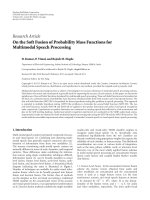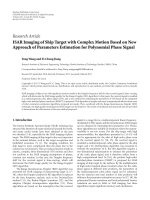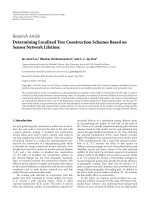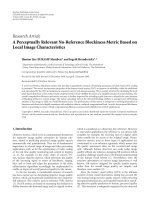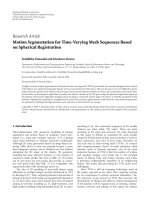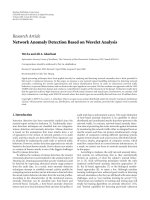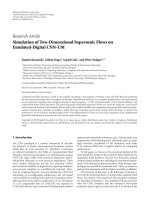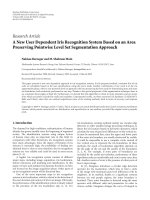Báo cáo hóa học: " Research Article On Energy-Efficient Hierarchical Cross-Layer Design: Joint Power Control and Routing for Ad Hoc Networks" pptx
Bạn đang xem bản rút gọn của tài liệu. Xem và tải ngay bản đầy đủ của tài liệu tại đây (835.33 KB, 9 trang )
Hindawi Publishing Corporation
EURASIP Journal on Wireless Communications and Networking
Volume 2007, Article ID 60707, 9 pages
doi:10.1155/2007/60707
Research Article
On Energy-Efficient Hierarchical Cross-Layer Design:
Joint Power Control and Routing for Ad Hoc Networks
Cristina Comaniciu
1
and H. Vincent Poor
2
1
Department of Electrical and Computer Engineer ing, Charles V. Schaefer Jr., School of Engineering,
Stevens Institute of Technology, Hoboken, NJ 07030, USA
2
Department of Electrical Engineering, School of Engineer ing and Applied Science, Princeton University, Princeton, NJ 08544, USA
Received 29 January 2006; Revised 20 October 2006; Accepted 30 December 2006
Recommended by Ananthram Swami
A hierarchical cross-layer design approach is proposed to increase energy efficiency in ad hoc networks through joint adaptation
of nodes’ transmitting powers and route selection. The design maintains the advantages of the classic OSI model, while accounting
for the cross-coupling between layers, through information sharing. The proposed joint power control and routing algorithm is
shown to increase significantly the overall energy efficiency of the network, at the expense of a moderate increase in complexity.
Performance enhancement of the joint design using multiuser detection is also investigated, and it is shown that the use of mul-
tiuser detection can increase the capacity of the ad hoc network significantly for a given level of energy consumption.
Copyright © 2007 C. Comaniciu and H. V. Poor. This is an open access article distributed under the Creative Commons
Attribution License, which permits unrestricted use, distribution, and reproduction in any medium, provided the original work is
properly cited.
1. INTRODUCTION
A mobile ad hoc network consists of a group of mobile
nodes that spontaneously for m temporar y networks with-
out the aid of a fixed infrastructure or centralized manage-
ment. Ad-hoc networks rely on peer-to-peer communica-
tion, where any source-destination pair of nodes can either
communicate directly or by using intermediate nodes to relay
the t raffic. The communication routes are determined by the
routing protocol, which finds the best possible routes accord-
ing to some specified cost criterion. Since, in general, many
ad hoc networks will consist of small terminals with limited
battery lifetime, routing protocols using energy-related cost
criteria have recently been investigated in the literature (e.g.,
[1–4]).
Aside from “energy-aware routing,” other interference
management techniques have the potential of improving
the system performance, with a direct effect on increas-
ing the network lifetime. For example, joint power control
and scheduling have been proposed in [5], and power-aware
routing for networks using blind multiuser receivers has been
analyzed in [1]. The benefits of power control for wireless
networks have been shown in numerous works (see, e.g., [6–
9]), but only recently have its interaction with “energy-aware
routing” begun to be addressed [10–13].
A power-aware routing protocol design relies on the cur-
rent power assignments at the terminals, and in turn, optimal
power assignment depends on the current network topol-
ogy, which is determined by routing. It is apparent that there
is a strong cross-coupling between power control and rout-
ing, due to the fact that they are both affected by, and act
upon, the interference level and the interference distribution
in the network. Given this strong coupling between layers, we
expect that cross-layer interference management algorithms
will outperform independently designed algorithms associ-
ated with various layers of the protocol stack [14]. On the
other hand, a concern associated with crossing the bound-
aries between layers is that many of the core advantages of the
OSI model, such as easy debugging and flexibility, easy up-
grading, and hierarchical time-scale adaptation, may be lost
[15].
As a tradeoff between the pros and cons of cross-layer de-
sign, we propose a hierarchical cross-layer design framework,
in which the adaptation protocols at different layers of the
protocol stack are independently designed (e.g., power con-
trol at the physical layer, and routing at the network layer),
while sharing coupling information across layers. Based on
this framework, we propose and analyze a joint power con-
trol and routing algorithm for code-division multiple-access
(CDMA) ad hoc networks. We then extend this algorithm to
2 EURASIP Journal on Wireless Communications and Networking
i
Network
layer
Physical
layer
MAC
layer
Figure 1: Hierarchical cross-layer design model: interactions
among physical, MAC, and network layers.
include multiuser detection, for a further increase in network
performance.
The paper is organized as follows: we first present the
hierarchical cross-layer design framework in Section 2.We
then propose a joint power control and routing algorithm
in Section 3, and we add multiuser detection capabilities for
the physical layer in Section 4. Finally, Section 5 presents the
conclusions.
2. HIERARCHICAL CROSS-LAYER DESIGN
FRAMEWORK
As we have already mentioned, a tight coupling exists be-
tween different interference management algorithms imple-
mented at various layers of the protocol stack. In this paper
we concentrate mainly on interactions between the physi-
cal and the network layers, namely, we consider power con-
trol and receiver adaptation algorithms at the physical layer,
and energy-aware routing at the network layer. While power
control and multiuser detection are traditional interference
management techniques, energy-aware routing can also be
seen as an effective interference management tool, as seeking
low-energy routes may lead to a better interference distribu-
tion in the network.
Given the tight cross-coupling among these techniques,
it becomes apparent that a cross-layer solution that jointly
optimizes interference management algorithms across layers
is desirable. On the other hand, the OSI classical layered ar-
chitecture has a number of advantages such as deployment
flexibility and upgradeability, easy debugg ing, and last but
not least, an inherent reduced network overhead by imple-
menting adaptability at different time scales. More specifi-
cally, fast adaptation can be done locally by the physical layer,
while large-scale events can be handled by changes in rout-
ing, which implies at least local neighborhood information
updates.
Our proposed hierarchical cross-layer design framework
seeks to maintain the advantages of the OSI model, by in-
dependently optimizing the interference management algo-
rithms based on information sharing among layers. Figure 1
illustrates this hierarchical model for the first three layers of
the protocol stack: physical layer, MAC (data link) layer, and
network layer. As protocols at different layers act indepen-
dently to increase the energy efficiency in the network, the in-
formation exchange between layers leads to an iterative adap-
tation procedure, in which layers take turns to adjust and
minimize the energy consumption in the network based on
the new interference level and distribution. We note that this
hierarchical structure raises convergence issues on a vertical
plane, and a key issue that should be addressed is how to ap-
propriately define the information shared between layers, as
well as how to incorporate this information such that the it-
erative cross-layer adaptation converges, and does not lead to
oscillatory behavior.
In what follows, we propose an energy-aware hierarchi-
cal joint power control and routing design, which we show is
guaranteed to converge across layers. We then study how fur-
ther enhancements at the physical layer (i.e., multiuser detec-
tion receivers in CDMA networks) improve the overall net-
work performance.
3. JOINT POWER CONTROL AND ROUTING
3.1. Network model
We consider an ad hoc network consisting of N mobile
nodes. For simulation purposes, the nodes are assumed to
have a uniform stationary distribution over a square area
of dimension D
∗
× D
∗
, but this is not a necessary assump-
tion for the analysis. The multiaccess scheme is synchronous
direct-sequence CDMA (DS-CDMA) and all nodes use in-
dependent, randomly generated, and normalized spreading
sequences of length L. The transmitted symbols (assumed to
be binary for the purpose of exposition) are detected using
either a matched filter receiver or a linear minimum square
errorreceiver(LMMSE).Eachterminal j has a transmission
power P
j
which will be iteratively and dist ributively adapted
according to the current network configuration. The traffic
can be transmitted directly between any two nodes, or it can
be relayed through intermediate nodes. It is assumed that
each node generates traffictobetransmittedtowardsaran-
domly chosen destination node. If t raffic is relayed by a par-
ticular node, the transmissions for different sessions at that
node are time-multiplexed. Also, it is assumed that a schedul-
ing scheme is available at the MAC layer to schedule trans-
mission and reception minislots for each node. This has the
role of avoiding exccesive interference between the received
and transmitted signals at any particular node. The details of
the scheduling allocation are beyond the scope of this paper.
For our design, we will use a simplifying worst-case assump-
tion that will consider that each node creates interference at
all times, while in reality, some of the time is dedicated only
to receiving. This s implifying assumption supports our hier-
archical structure, by avoiding interference tracking (routes
modification) at the MAC layer time scale.
We address the problem of meeting quality of service
(QoS) requirements for data, that is, BER (bit error rate)
and minimum energy expenditure for the information bits
transmitted, to conserve battery power. We note that for data
C. Comaniciu and H. V. Poor 3
services, delay is not of primary concern. The target BER
requirement can be mapped into a target SIR requirement.
We note that an optimal target SIR can be determined (as
in [16]) to minimize the energy per bit requirement, under
the assumption that data is retransmitted until correctly re-
ceived.
At a link level, for a given target SIR requirement, the
number of retransmissions necessary for correct packet re-
ception is characterized by a geometric distribution, which
depends on the corresponding BER-SIR mapping. If the
transmission rate is fixed for all links, then the energy can be
minimized by minimizing the transmitted powers on each
link. At the physical layer level, this is achieved by power
control. However, the achievable minimum powers will de-
pend on the distribution of the interference in the network,
and thus are influenced by routing. In turn, routing may use
power-aware metrics to minimize the energy consumption.
The overall cross-layer optimization problem can be formu-
lated as follows:
minimize
N
i=1
P
i
subject to SIR
(i, j)
(p) ≥ γ
∗
,
∀(i, j) ∈ S
r
a
, P
i
≥ 0, r ∈ Υ,
(1)
where (p) is the vector of all nodes’ powers, S
r
a
is the set of
active links for the current routing configuration r, obtained
using the routing protocol, and Υ is the set of all possible
routes.
From (1), we can see that optimal power allocation de-
pends on the current route selection. On the other hand,
for a given power allocation, efficient routing may reduce
the interference, thus further decreasing the required energy
per bit. We begin our discussion of the joint optimization of
these two effects by first considering dist ributed power con-
trol design for a given route assignment, which is a classic
distributed power control problem for ad hoc networks.
3.2. Distributed power control
In the cellular setting, a minimal power transmission solu-
tion is achieved when all links achieve their target SIRs with
equality. For an ad hoc network, implementation complex-
ity constraints may restrict the power control to adapt power
levels for each node, as opposed to optimizing it for each ac-
tive outgoing link for the node. If multiple active transmis-
sion links start at node i (Figure 2), then the worst link must
meet the target SIR with equality. In our model, these outgo-
ing links correspond to destinations for various flows relayed
by the node, and are used in a time-multiplexed fashion.
If we denote the set of all outgoing links from node i as
S
∗
i
, then the minimal power transmission conditions become
min
k∈S
∗
i
SIR
k
= γ
∗
, ∀i = 1, 2, , N. (2)
We now express the achievable SIR for an arbitrary active
link (i, j)
∈ S
r
a
:
SIR
(i, j)
=
h
(i, j)
P
i
(1/L)
N
k=1, k=i, k= j
h
(k, j)
P
k
+ σ
2
,(3)
j
l
m
i
.
.
.
Figure 2: Multiple transmissions from node i.
where h
(i, j)
is the link gain for link (i, j), and σ
2
is the back-
ground noise power.
Condition ( 2) can then be expressed as
min
(i, j)∈S
∗
i
h
(i, j)
P
i
(1/L)
N
k
=1, k=i, k=j
h
(k, j)
P
k
+ σ
2
= γ
∗
. (4)
From (4), the powers can be selected as
P
i
= max
(i, j)∈S
∗
i
γ
∗
h
(i, j)
1
L
N
k=1, k=i, k= j
h
(k, j)
P
k
+ σ
2
=
max
(i, j)
I
(i, j)
(p),
(5)
where p
T
= [P
1
, P
2
, , P
N
].
It can easily be shown that I
(i, j)
(p) is a standard inter-
ference function, that is, it satisfies the three properties of
a standard interference func tion: positivit y, monotonicity,
and scalability [ 17]. It was also proved in [17] that T
i
(p) =
max
(i, j)
I
(i, j)
(p) is also a standard interference function. Since
T
i
(p) is a standard interference function, for a feasible sys-
tem, an iterative power control algorithm based on
P
i
(n +1)= T
i
p(n)
, ∀i = 1, 2, , N,(6)
is convergent to a minimal power solution [17], for both syn-
chronous and asynchronous power updates.
Since all the infor mation required for the power up-
dates can be estimated locally, the power control algorithm
can be implemented distributively. In particular, a sample
average of the square root outputs of the matched filter
receiver for link (i, j) will determine the quantity E
{y
2
(i, j)
}=
(1/L)
N
k
=1, k=i, k=j
h
(k, j)
P
k
+ h
(i, j)
P
i
+ σ
2
. Further, if the link
gain h
(i, j)
is also estimated, all information required for
power updates at node i is available locally.
3.3. Joint power control and routing
The previous section has proposed an optimal power con-
trol algorithm, which minimizes the total transmitted power
given SIR constraints for all active links, for a given network
configuration. However, the performance can be further im-
proved by optimally choosing the routes as well. Finding the
4 EURASIP Journal on Wireless Communications and Networking
Initial distribution
of powers and routes
Power
control
Update link costs
Compute routes
Update routes
Yes
N
i=1
P
i
lower ?
No
Stop
Figure 3: Joint power control and routing.
optimal routes to minimize the total transmission power over
all possible configurations is an NP-hard problem.
We propose a suboptimal solution, based on iterative
power control and routing, which is shown to converge
rapidly to a local minimum energy solution. This solu-
tion is compatible with our proposed hierarchical cross-layer
framework, by promoting independent protocol updates
with information sharing accross layers. More specifically, we
propose a joint algorithm that alternates between power con-
trol (at the physical layer) and route assignments (at the net-
work layer), until further improvements in the energy con-
sumption cannot be achieved. At each step of the algorithm,
the power control optimizes powers based on the current
route assignment, while after power assignment, new min-
imum energy routes are determined based on the current
power distribution of the nodes (see Figure 3).
As we have mentioned in Section 3.1, the optimization
problem that we are solving can be expressed as in (1), that is,
we try to minimize the sum of transmission powers, subject
to SIR constraints, by both power control and route assign-
ments. We note that the target SIR requirement is selected
such that a BER requirement is met for a fi xed prescribed
rate allocation, determined by a prescribed spreading gain.
Thus, in our system model the transmission rate is fixed.
In the previous section, we have described how the trans-
mission powers are chosen for each node given a current
route configuration, and we have shown that for our system
model, they are unique per node, no matter which flow is
currently relayed by the node.
Thus, the information that the network layer sees is the
vector of powers for all the nodes, p
T
= [P
1
, P
2
, , P
N
],
which completely characterizes the interference distribution
in the system, given a certain location for the nodes.
For routing, we use Dijkstra’s algorithm [18, 19]withas-
sociated costs for the links. In order to try to minimize fur-
ther the total transmitted power in the network, a natural
choice of costs for the routing would be based on the trans-
mission power spent by a node sending on a given link. How-
ever, for convergence reasons for the cross-layer algorithm
(which will be explained shortly), the cost for an arbitrary
link (i, j) is determined as
c(i, j)
=
⎧
⎨
⎩
P
i
if SIR
(i, j)
≥ γ
∗
,
∞ if SIR
(i, j)
<γ
∗
.
(7)
The reason for choosing the link costs as in (7) is that we
would like to restrict the pool of links available for routing to
include only links that already meet the target SIR. As we will
see shortly, this condition will ensure the convergence of the
algorithm towards a minimum energy solution.
To determine a better possible routing option, we need to
evaluate the new costs for all links, given the current distribu-
tion of powers resuling from the previous power control step.
In order to determine the routing costs for the links that are
not currently active, the achievable SIR for these links must
be estimated. This requires that each node i update a rout-
ing table which should contain the estimated link gains to-
wards all the other nodes, h
(i, j)
, j = 1, 2, , N, j = i, the
transmitted powers of all nodes, P
j
, j = 1, 2, , N, and the
extended estimated interference at all the other nodes, de-
fined as
I(i, j) =
N
k=1, k=i, k= j
h
(k, j)
P
k
+h
(i, j)
P
i
, j = 1, 2, , N,
j
= i. Hence, the estimated SIR for link (i, j) can be expressed
as
SIR
(i, j)
=
h
(i, j)
P
i
(1/L)
I(i, j) − h
(i, j)
P
i
+ σ
2
. (8)
We note that the achievable SIR on any potential link
(currently active or not) depends only on the current distri-
bution of nodes, and on the current power assignment, and
does not depend on the current assigned routes, and con-
sequently does not change for new route assignments. This
property is a result of the fact that multiple sessions are time-
multiplexed at a node, and are all transmitted with the same
power, such that the transmitted power for a node i is fixed
and equal to P
i
. This result can be summarized in the follow-
ing proposition.
Proposition 1. For a given distribution of nodes in the net-
work, after the convergence of the p ower control algorithm, the
achievable SIR on any arbitrary link de pends only on the nodes’
transmitted powers and is independent of the cur rent route as-
signment.
We note that if sessions are not time-multiplexed at a re-
laying node, the above proposition does not hold any more
(e.g., the total power transmitted by a node is additive over
the number of relayed flows for multicode transmission, and
thus depends on the routing configuration), and the con-
vergence of the proposed joint power control algorithm is
not guaranteed. However, as a disadvantage for the time-
multiplexed scheme, the throughput per session is limited by
the number of sessions relayed by a node. In an extension
of this work [20], we also have proposed a cost modifica-
tion for the routing to account for this effect, which yielded a
more uniform distribution of relayed flows per node over the
entire network. Also, in [21], we have compared the per for-
mance of a time-multiplexed scheme with the case in which
multi-code CDMA is used for simultaneous transmission of
C. Comaniciu and H. V. Poor 5
all relayed flows (which increases the interference in the sys-
tem).
Starting from an initial distribution of powers and routes,
and assuming that the system is feasible for the initial con-
figuration, the joint power control and routing algorithm is
summarized in Figure 3.
Theorem 1. For a feasible initial network configuration, the
joint power control and routing algorithm converges to a locally
minimal transmitted power solution.
Proof. As we previously showed, for a feasible initial network
configuration, the power control minimizes the total trans-
mitted power, while ensuring that all active links meet their
SIR requirements: SIR
(i, j)
≥ γ
∗
,forall(i, j) ∈ S
r
a
. After the
convergence of the power control algorithm, the link costs
are estimated and updated according to (7)and(8), and
a minimal cost route, equivalent to a minimal transmitted
power route, is selected for each session. As a consequence,
the new routes are selected such that the sum of all trans-
mitted powers for all active links is minimized, while the SIR
constraints are met for all links (from Proposition 1 and (7)).
If no power improvements can be achieved, the algorithm
stops. Otherwise, the sum of transmission powers decreases
after the route selection. Since all the new active links sat-
isfy SIR
(i, j)
≥ γ
∗
,forall(i, j) ∈ S
r
a
, the system is feasible,
and therefore, the power control algorithm produces a de-
creasing sequence of power vectors converging to a minimal
power solution [17].
Hence, each step of the iteration (power control or
routing) produces an improvement in the total transmitted
power, while meeting SIR requirements for all active links.
The algorithm stops at a locally minimal transmitted power
solution, where no further decrease in transmission power
can be achieved by the routing protocol.
We note that the locally minimal transmitted power so-
lution achieved by the proposed algorithm depends on the
initial network configuration chosen. For initialization, we
propose an algorithm similar to that which was proposed in
[1]. We first select an initial distribution of powers (equal
powers or random distribution) and then determine routes
by assigning link costs equal to the energy-per-bit consump-
tion, which is proportional to the transmitted power and in-
verse proportional to the probability of correct reception for
apacket[15]. This approach also permits us to quantify the
energy requirement improvements of the joint optimization
relative to the initial starting point.
We note that the total energy requirement depends on
the current initialization for the powers. To improve the ex-
panded energy with minimal complexity increase, the algo-
rithm can be run several times with different random power
initializations, and the best energy solution over all runs can
be determined.
3.4. Simulations
In this section, we present some numerical examples for ad
hoc networks with 55 and 40 nodes, respectively, uniformly
01020304050
0
0.5
1
1.5
2
2.5
3
3.5
4
×10
−7
Figure 4: Distribution of powers after convergence.
distributed over a square area of 200 × 200 meters. The
target SIR is selected to be γ
∗
= 12.5 (which was shown
to be an optimal value that minimizes energy-per-bit con-
sumption for an FSK scheme [16]), and the noise power is
σ
2
= 10
−13
, which approximately corresponds to the thermal
noise power for a bandwidth of 1 MHz. We consider low-rate
data users, using a spreading gain of L
= 128. For this partic-
ular example, we choose equal initial transmit powers, 70 dB
above the noise floor (P
t
= 10
−6
W), and a path loss model
with path loss coefficient n
= 2.
In Figure 4, we show the final distribution of powers af-
ter the convergence of the joint power control and routing
algorithm. Figures 5 and 6 illustrate the performance of the
proposed joint optimization algorithm. In Figure 5,itcanbe
seen that the total transmitted power in the network progres-
sively decreases as the proposed algorithm iteratively opti-
mizes power and routes. The values in Figure 5 represent the
total transmitted power obtained over a sequence of itera-
tions: (power control, routing, power control, routing, power
control). In Figure 6, the achieved energy per bit is compared
for the same experiment with the first energy value, which
represents the energy per bit obtained in the initial state. It
can be seen that substantial improvements are achieved by
the proposed joint optimization algorithm.
Note that at the end of each iteration pair (routing, power
control), the energy is further minimized. However, after
new routes are selected, the powers are not yet optimized, so
it is possible that previous routes might have better energy-
per-bit performance (for the same power allocation, higher
SIRs may improve the energy consumption).
As we have previously mentioned, the actual energy re-
sults after convergence depend on the initial starting point
for the algorithm. In Figure 7, we illustrate the variation in
the total transmission power obtained with v arious initial-
izations (100 trials are considered) for an ad hoc network
with 40 nodes. We can see that significant energy improve-
ments can be achieved if the algorithm is run repeatedly with
different initializations and the best configuration is selected.
6 EURASIP Journal on Wireless Communications and Networking
11.522.533.544.55
6
6.5
7
7.5
8
8.5
9
×10
−5
Iterations
Total transmitted power
prp
r
p
Figure 5: Total transmission power.
123456
10
−5
10
−4
10
−3
Iterations
E
b
Initialization
p
r
p
rp
Figure 6: Energy per bit.
0 20406080100
10
−6
10
−5
10
−4
10
−3
Number of initializations
P
t
E
min
Figure 7: Energy function for different initializations.
0 5 10 15 20 25 30 35 40
0
0.2
0.4
0.6
0.8
1
1.2
1.4
1.6
1.8
2
×10
−7
P
av
Figure 8: Distribution of powers for the minimal energy solution.
In Figure 8 we show the final distribution of powers for this
minimal energy solution.
3.5. Uniform energy consumption
While we saw that the power distribution in Figure 8 gives
a very low total energy consumption, this solution leads to
unequal power consumption among nodes, which ultimately
results in shorter life span for certain nodes (e.g., node 14 in
Figure 8). Note that in mobile nodes, this problem is over-
come by the fact that node locations change with time, so in
the long run, the power consumption tends to be more uni-
form.
For fixed nodes, or slow moving ones, we overcome this
problem by selecting a set of alternate “good routes” (N
s
routes) and their corresponding power distributions. The
routes (and power vectors) are then randomly assig ned, such
that the power consumption var iance among nodes is min-
imized. A route i and its corresponding power vector p
i
are
selected from the initial set of “good routes,” with probability
w
i
. The probabilities w
i
, i = 1, , N
s
, are assigned to routes
such that the following conditions hold:
min
w
P − P
av
2
2
,
0
≤ w
i
≤ 1, i = 1, , N
s
,
N
s
j=1
w
j
= 1,
(9)
where w
= [w
1
, w
2
, , w
N
s
], P = [p
1
, p
2
, , p
N
s
], and P
av
is the average power consumption across nodes obtained for
the minimal energy solution.
Alternatively, routes can be assigned deterministically,
such that w
i
represents the fraction of time route i and its
corresponding power vector are selected for transmission. In
Figure 9 we illustrate how the power distribution changes in
the ad hoc network when N
s
= 9 “good routes” are selected.
These routes (and their corresponding power distribution)
C. Comaniciu and H. V. Poor 7
0 5 10 15 20 25 30 35 40
0
0.2
0.4
0.6
0.8
1
1.2
1.4
×10
−7
P
av
Uniform distribution of powers
Figure 9: Energy per bit.
are selected to be within 10% of the minimal energy solution
obtained with 100 different random initializations. Compar-
ing the results from Figure 9 with the ones in Figure 8,we
can see a more uniform consumption across all nodes in the
ad hoc network.
4. JOINT POWER CONTROL, ROUTING, AND
MULTIUSER DETECTION
To extend the above-described joint power control and rout-
ing algorithm to include receiver optimization, we build on
results on iterative, distributed, joint power control, and
minimum mean square error multiuser detection presented
in [22]. In [22], an iterative two-step integrated power con-
trol and multiuser detection algorithm was proposed, for
which, in the first step, the LMMSE filter coefficients are ad-
justed according to the current vector of powers p (10), then
in the second step, a new power vector is selected for the given
filter coefficients.
Step 1. Optimize filter coefficients given the power vector
p
T
= [P
1
, P
2
, , P
n
]:
c
i
=
P
i
(n)
1+P
i
(n)s
T
i
A
−1
i
p(n)
s
i
A
−1
i
p(n)
s
i
, (10)
where c
i
and s
i
are the filter coefficients vector, and the signa-
ture sequence vector for user i,respectively,n is the iteration
number, and A
i
is defined as A
i
=
j=i
P
j
h
ij
s
j
s
T
j
.
Step 2. Optimize powers based on currently selected filter co-
efficients:
P
i
(n +1)=
γ
∗
i
h
ii
j=i
P
j
(n)h
i, j
c
i
T
s
j
2
+ σ
2
c
i
T
c
i
c
i
T
s
i
2
. (11)
Given the above algorithm, to extend our joint power
control and routing scheme to include receiver optimization,
we simply replace the simple power control adaptation at the
0 5 10 15 20 25 30
0
0.1
0.2
0.3
0.4
0.5
0.6
0.7
0.8
0.9
1
×10
−5
(a)
0 5 10 15 20 25 30
0
0.1
0.2
0.3
0.4
0.5
0.6
0.7
0.8
0.9
1
×10
−5
(b)
Figure 10: Joint power control, multiuser detection, and routing:
distribution of powers versus n ode number, (a) initially, (b) after
convergence (final distribution of powers).
physical layer by the above joint power control and multiuser
detection algorithm.
Simulation results show a very similar convergence be-
havior and energy savings for the joint power control, mul-
tiuser detection and routing algorithm, compared to the so-
lution with matched filters (see Figures 10, 11,and12). We
also note a significant capacity increase when multiuser de-
tection is employed. We use as a capacity measure the total
throughput that can be supported by the network such that
the power control is feasible for a target SIR of γ
∗
= 12.5.
We note that the power control feasibility depends on the ac-
tual network topolog y. To determine the maximum load for
the network, we randomly generated 100 different topologies
(for the same number of users) and we selected the max-
imum number of users (for a given spreading gain) that
yielded feasible topologies 95% of the time, for a given ini-
tial power distribution for the nodes.
8 EURASIP Journal on Wireless Communications and Networking
123
6.8
7
7.2
7.4
7.6
7.8
8
8.2
8.4
8.6
8.8
×10
−5
p+MUD
r
p+MUD
Iterations
Total transmitted power
Figure 11: Total transmission power: joint power control, mul-
tiuser detection, and routing.
11.522.533.54
10
−5
10
−4
10
−3
Iterations
E
b
Initialization
p+MUD
r
p+MUD
Figure 12: Total energy consumption: joint power control, mul-
tiuser detection, and routing.
For the matched filter case, we selected L = 128 and the
maximum number of users that met the feasibility condition
was determined to be N
= 55. For the LMMSE case, since
the capacity increases significantly, to reduce the complexity
of the simulation (the number of nodes), we have selected
L
= 32, with a resulting capacity of N = 30. This yielded a
total normalized throughput gain for the LMMSE case of
T
g(LMMSE)
=
N
LMMSE
× L
MF
L
LMMSE
× N
MF
= 2.18. (12)
To illustrate the performance of the joint power con-
trol, multiuser detection and routing protocol, we have con-
sidered similar network parameters as before, with the sole
difference of selecting N
= 30 and L = 32. Random ini-
tial tr ansmission powers were selected, approximately 70 dB
above the noise floor.
Figure 10 shows the initial distribution of powers, as well
as the optimal power control distribution after convergence.
Figures 11 and 12 illustrate the performance of the pro-
posed joint optimization algorithm with multiuser detection.
In Figure 11, it can be seen that the total transmitted power
in the network progressively decreases as the proposed al-
gorithm iteratively optimizes power, filter coefficients, and
routes. The values in Figure 11 represent the total transmit-
ted power obtained over a sequence of iterations: (power
control + MUD, routing, power control + MUD, routing,
power control + MUD).
In Figure 12, the achieved energy per bit is compared for
the same exper iment with the initial energy value (with ran-
domly selected powers). It can be seen that substantial im-
provements are achieved by the proposed joint optimization
algorithm (approximately one order of magnitude).
5. CONCLUSIONS
In this paper, we have proposed joint power control and
routing optimization for wireless ad hoc data networks with
energy constraints. Both energy minimization and network
lifetime maximization have been considered as optimization
criteria. We have shown that energy savings of an order of
magnitude can be obtained, compared with a fixed trans-
mission power, energy-aware routing scheme. Our proposed
algorithm is based on a hierarchical cross-layer framework
which maintains the advantages of the OSI layered archi-
tecture, while allowing for protocol optimization based on
information sharing between layers. The network capacity
has been further enhanced by employing multiuser detec-
tion, with a similar obtained energy performance. Our sim-
ulation results show that our distributive joint optimization
algorithm converges rapidly towards a local minimum en-
ergy. The rapid convergence of the power-routing protocol
makes it suitable for implementation in mobile ad hoc net-
works.
ACKNOWLEDGMENTS
This work was presented in part at the 42nd IEEE Conference
on Decision and Control, Maui, Hawaii, December 2003.
This research was supported by the National Science Foun-
dation under Grants ANI-03038807 and CCR-02-05214, by
the New Jersey Center for Pervasive Information Technology,
and by iNetS Center at Stevens Institute of Technology.
REFERENCES
[1] Z. Cai, M. Lu, and X. Wang, “Minimum average transmission
power routing in CDMA ad hoc networks utilizing the blind
multiuser detection,” in Proceedings of the 16th International
Parallel and Distributed Processing Symposium (IPDPS ’02),pp.
428–433, Fort Lauderdale, Fla, USA, April 2002.
[2]D.Kim,J.J.Garcia-Luna-Aceves,K.Obraczka,J.Cano,and
P. Manzoni, “Power-aware routing based on the energy drain
rate for mobile ad hoc networks,” in Proceedings of the 11th
IEEE International Conference on Computer Communications
and Networks (ICCCN ’02), pp. 565–569, Miami, Fla, USA,
October 2002.
C. Comaniciu and H. V. Poor 9
[3] X Y. Li, P J. Wan, Y. Wang, and O. Frieder, “Constrained
shortest paths in wireless networks,” in Proceedings of IEEE
Military Communications Conference (MILCOM ’01), vol. 2,
pp. 884–893, McLean, Va, USA, October 2001.
[4] S. Tragoudas and S. Dimitrova, “Routing with energy consid-
erations in mobile ad-hoc networks,” in Proceedings of IEEE
Wireless Communications and Networking Conference (WCNC
’00), vol. 3, pp. 1258–1261, Chicago, Ill, USA, September 2000.
[5] T. ElBatt and A. Ephremides, “Joint scheduling and power
control for wi reless ad-hoc networks,” in Proceedings of the
21st I EEE Annual Joint Conference of the IEEE Computer and
Communications Societies (INFOCOM ’02), vol. 2, pp. 976–
984, New York, NY, USA, June 2002.
[6] S. Agarwal, R. H. Katz, S. V. Krishnamurthy, and S. K. Dao,
“Distributed power control in ad-hoc wireless networks,” in
Proceedings of the 12th International Symposium on Personal,
Indoor and Mobile Radio Communications (PIMRC ’01), vol. 2,
pp. F-59–F-66, San Diego, Calif, USA, September-October
2001.
[7] M. Ettus, “System capacity, latency, and power consumption
in multihop-routed SS-CDMA wireless networks,” in Proceed-
ings of IEEE Radio and Wireless Conference (RAWCON ’98),pp.
55–58, Colorado Springs, Colo, USA, August 1998.
[8] T. J. Kwon and M. Gerla, “Clustering with power control,”
in Proceedings of IEEE Military Communications Conference
(MILCOM ’99), vol. 2, pp. 1424–1428, Atlantic City, NJ, USA,
October-November 1999.
[9] F.Meshkati,H.V.Poor,S.C.Schwartz,andN.B.Mandayam,
“An energy-efficient approach to power control and receiver
design in wireless data networks,” IEEE Transactions on Com-
munications, vol. 53, no. 11, pp. 1885–1894, 2005.
[10] F. Bertocchi, P. Bergamo, G. Mazzini, and M. Zorzi, “MAC and
routing solution for energy saving in ad hoc networks: dis-
tributed power control,” in Proceedings of the Joint Conference
of the 4th International Conference on Information, Communi-
cations and Signal Processing, and the 4th Pacific Rim Confer-
ence on Multimedia (ICICS-PCM ’03), vol. 2, pp. 1061–1065,
Singapore, December 2003.
[11]C.Comaniciu,N.B.Mandayam,andH.V.Poor,Wireless
Networks: Multiuser Detect ion in Cross-Layer Design, Springer,
New York, NY, USA, 2005.
[12] C. Comaniciu and H. V. Poor, “QoS provisioning for wireless
adhocdatanetworks,”inProceedings of the 42nd IEEE Confer-
ence on Decision and Control, vol. 1, pp. 92–97, Maui, Hawaii,
USA, December 2003.
[13] A. Yener and S. Kishore, “Distributed power control and
routing for clustered CDMA wireless ad hoc networks,” in
Proceedings of the 60th IEEE Vehicular Technology Conference
(VTC ’04), vol. 4, pp. 2951–2955, Los Angeles, Calif, USA,
September 2004.
[14] A. J. Goldsmith and S. B. Wicker, “Design challenges for
energy-constrained ad hoc wireless networks,” IEEE Wireless
Communications, vol. 9, no. 4, pp. 8–27, 2002.
[15] V. Kawadia and P. R. Kumar, “A cautionary perspective
on cross-layer design,” Tech. Rep., University of Illinois at
Urbana-Champaign, Urbana, Ill, USA, 2003.
[16] D. Goodman and N. Mandayam, “Power control for wireless
data,” IEEE Personal Communications, vol. 7, no. 2, pp. 48–54,
2000.
[17] R. Yates, “A framework for uplink power control in cellular
radio systems,” IEEE Journal on Selected Areas in Communica-
tions, vol. 13, no. 7, pp. 1341–1348, 1995.
[18] “Bayes Net Toolbox for Matlab,” />[19] D. Bertsekas and R. Gallager, Data Networks, Prentice-Hall,
Upper Saddle River, NJ, USA, 1992.
[20] Y. Xing, N. Nie, and C. Comaniciu, “Avoiding throughput bot-
tlenecks for energy efficient joint power control and routing in
ad hoc wireless networks,” in Proceedings of the Conference on
Information Sciences and Systems
, Princeton, NJ, USA, March
2004.
[21] H. Mahmood and C. Comaniciu, “Adaptive spreading/coding
gains for energy efficient routing in wireless ad hoc networks,”
in Proceedings of the 61st IEEE Vehicular Technology Conference
(VTC ’05), vol. 4, pp. 2454–2458, Stockholm, Sweden, May-
June 2005.
[22] S. Ulukus and R. Yates, “Adaptive power control and multiuser
interference suppression,” ACM Wireless Networks, vol. 4,
no. 6, pp. 489–496, 1998.

